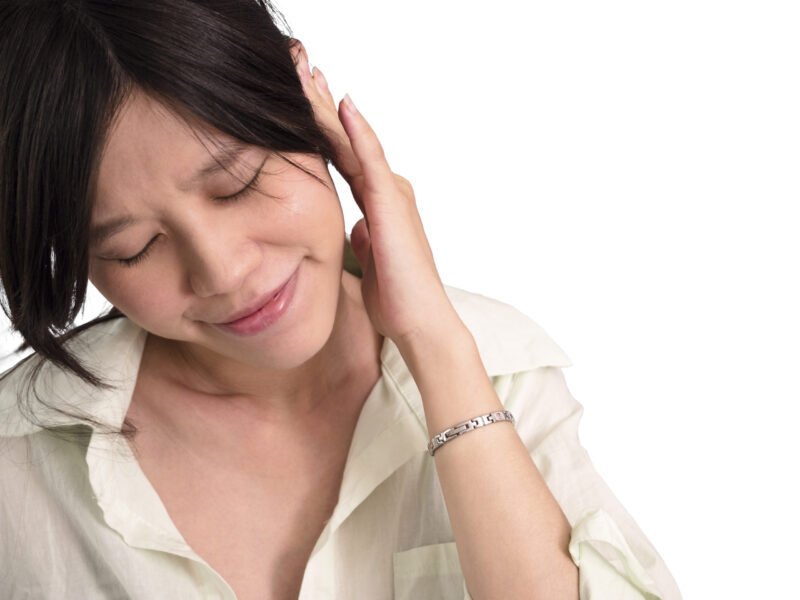Fluttering in ear—-Tinnitus— is a ringing or buzzing sound or noise in the ear. The particular characteristic is that the sound originates within the patient. It usually affects only one ear, although it might impact both. The patient has described it as a roaring, hissing, swishing, rustling, or clicking sound. Tinnitus is more irritating in quiet environments, especially at night, when the masking effect of outside noise is eliminated.
Types of Tinnitus
Two types of tinnitus are described.
- Subjective, which can only be heard by the patient.
- Objective, which can even be heard by the examiner with the use of a stethoscope.
i. Subjective Tinnitus
a. Subjective Tinnitus “Fluttering in ear” can originate in the external ear, middle ear, inner ear, VIIIth nerve, or central nervous system.
b. Anemia, arteriosclerosis, hypertension, and some medicines may all have an effect on the inner ear or central auditory system.
c. When a patient has conductive hearing loss, he or she may experience strange noises in the head during eating, speaking, or even breathing.
Some other causes of Subjective Tinnitus are as:
ii. Otologic
- Impacted wax.
- Fluid in middle ear
- Acute otitis media
- Chronic otitis media
- Meniere’s disease
- Noise-induced hearing loss
- Idiopathic sudden SNHL
iii. Metabolic
- Hypothyroidism
- Hyperthyroidism
- Obesity
- Hyperlipidaemia
- Vitamin deficiency (e.g. B12)
iv. Neurologic
- Injury of head or skull bone fractures
- Multiple sclerosis
- Post Meningitic
v. Cardiovascular
- Hypertension / Hypotension
- Anaemia
- Cardiac arrhythmias
- Arteriosclerosis
vi. Pharmacologic
- Certain drugs used by the patient
- All ototoxic drugs
vii. Psychogenic
- Anxiety
- Depression
Objective Tinnitus
Tinnitus ‘Fluttering in ear” that is objective is less common. Vascular lesions, such as a glomus tumour or a carotid artery aneurysm, create swishing tinnitus that is synchronised with the pulse. It can be temporarily stopped by putting pressure on the common carotid artery. Venous hum can occasionally be ended by applying pressure to the veins in the neck.
Some other causes of Objective Tinnitus are as:
Vascular
i. AV shunts
- Congenital AV malformations
- Glomus tumour of middle ear
ii. Arterial bruit
- Carotid aneurysm
- Carotid stenosis
- Vascular loop pressing on VIIIth nerve in internal auditory canal
iii. Venous Hum
- Dehiscent jugular bulb
- Patulous eustachian tube
- Palatal myoclonus
- Idiopathic stapedial or tensor tympani myoclonus
- Dental
- Clicking of TM joint
Tinnitus associated with Respiration
Tinnitus associated with respiration can develop when the eustachian tube is abnormally patent. Palatal myoclonus, which creates a clicking sound due to clonic contraction of the soft palate muscles, is easily detected. Clonic contraction of middle ear muscles (stapedius and tensor tympani) can induce tinnitus, which is sometimes difficult to identify.
Psychogenic Tinnitus
Tinnitus can be psychogenic, with no known origin in the ear or central nervous system.
Tinnitus or fluttering in ear differs from auditory hallucinations, which occur when a person hears voices or other organised sounds such as music. It is observed in psychiatric diseases.
Treatment of Tinnitus
Tinnitus is a symptom, not a medical condition. Wherever possible, the cause should be identified and treated. Fluttering in ear may not always be relieved by treating the underlying cause. When no cause is established, tinnitus management includes:
Psychotherapy and reassurance
Often, the sufferer must learn to live with tinnitus.
Techniques for relaxation and biofeedback.
Sedation and sedatives
They may be required in the early stages until the patient has adjusted to the symptom.
Tinnitus masking
Tinnitus is more annoying at night, when the surroundings are quiet. The use of a fan, a loudly-clicking clock, or a similar item may assist the patient sleep by masking the tinnitus. Hearing aids not only increase hearing but also provide a masking effect in people who have hearing loss.
Tinnitus maskers can be utilised in patients with normal hearing. They are worn in the same way that hearing aids are. Tinnitus masker use for a short length of time may provide a symptom-free period for several hours in some individuals due to the occurrence of residual inhibition.
Tinnitus Instrument
It is a combination of a hearing aid and a masker in one device. Looks like a hearing aid. Both hearing aids and masking devices have independent volume controls.
Tinnitus Retraining Therapy (TRT)
Jastreboff of the University of Maryland established a neurophysiologic model for tinnitus development that serves as the foundation for habituation therapy. It assumes that tinnitus is not as irritating as the emotional responses created by the limbic and autonomic systems. His therapeutic Approach tries to reduce connections between the auditory, limbic, and autonomic nerve systems, resulting in tinnitus habituation. It happens on two levels.
i. Reaction Habituation
It is the separation of the brain and body from negative responses to tinnitus.
ii. Tinnitus Habituation
It inhibits tinnitus-related neural activity from reaching the level of consciousness. Patients with tinnitus who receive this therapy lose awareness of their tinnitus and do not become irritated even when they do have tinnitus or fluttering in ear.
Therapy is divided into two parts: (i) counselling and (ii) sound therapy.
iii. Counselling
It is essential to educate the patient about tinnitus, its generational process, tinnitus perception at the subcortical and cortical levels, and the plasticity of the brain, which can habituate any sensory stimulation. The limbic system (emotions) and autonomic system (body reactions) are the primary causes of negative tinnitus reactions, such as sleep disruption, inability to focus, aggravation, anxiety, and sadness, rather than the tinnitus itself.
iv. Sound therapy
Patient is exposed to external sounds, music, radio, television, or the use of hearing aids (if he has hearing loss). In general, he should avoid being in a quiet setting. Sound generators are employed to create external sound for habituation, producing continuous low-level, broad-band noise for at least 8 hours each day.
Sound here is used not for concealing the fluttering in ear but is regulated to remain at a low level, for habituation.
TRT takes 18-24 months but results in a significant improvement in more than 80% of patients.
Conclusion
Tinnitus–fluttering in ear— is not a disease but a symptom for many medical conditions. The causes of Tinnitus can be systemic, metabolic, neurogenic, psychogenic and idiopathic or unknown origin. This condition can be treated by managing the underlying cause or symptomatically by certain medications such as sedatives, rassurance and certain techniques such as masking. TRT can also be used to manage fluttering in ear as it reduces connections between the auditory, limbic, and autonomic nerve systems, resulting in tinnitus habituation.
Frequently Asked Questions:
Q. Will my tinnitus or fluttering in ear worsen?
Ans. It is comforting to know that tinnitus almost typically improves with time. We know that persons who receive proper medical care, accurate information, and effective therapy and support have a better chance of long-term recovery.
Q. Does my tinnitus ever go away?
Ans. The vast majority of new tinnitus or fluttering in ear cases resolve within 6-12 months of beginning. Even if your tinnitus has been present for a longer amount of time, you are likely to hear it less frequently over time.
Q. Will my tinnitus harm my hearing?
Ans. Tinnitus is frequently perceived as the first indicator of a change in hearing health. Tinnitus is usually a sign of hearing alteration and does not cause or worsen hearing.
Q. What is the source of the noise?
Ans. Tinnitus can come from anywhere in your auditory system, from the outer ear to the brain (see How We Hear for additional information). It is a real signal reaching the brain, not something you are imagining, and its source is within the body.
Q. Can others hear my tinnitus?
Ans. Tinnitus that may be heard through your ear canal is quite rare. These are incredibly quiet sounds that others cannot hear unless they are very close or use a microphone and amplification.



